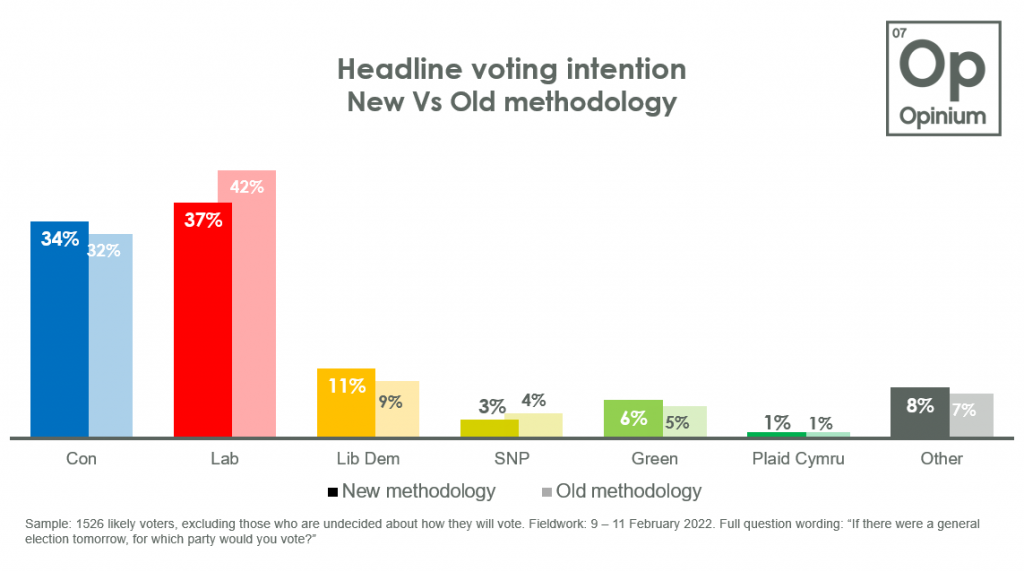
Image: Opinium’s methodology change from February 2022
As we head into the final stretch before the General election, the polls loom larger in the minds of pundits and political punters.
The basic polling question is a hypothetical one “If there was a General Election tomorrow, how would you vote?” When we all know that the real election is months away, and people will change their minds. As the wider public increases interest polls are likely to move, the fabled “swingback” that we tend to see once the campaigning starts.
The degree of swingback varies from election to election, but comprises several factors. The first is genuine changes of mind between parties, and this seemed to be a very real phenomenon in the 2017 GE. This is rather unpredictable so while important to political punters for “in game betting” cannot be assessed in advance. This is why political betting remains a game of chance.
The second factor is turnout, particularly when varying by demographic factors such as age and social class. Turnout of the young was probably a big factor in 2017 too, and a voter strike by Tory voters was key in John Major’ defeat in 1997. This perhaps merits its own header.
A third factor is what happens to the Undecided voters who say they will very likely vote. The polling companies take a variety of approaches to these, and this does seem to account for at least part of the “house effect” where some pollsters appear to favour one party over another. It is worth looking at the approaches by different pollsters.
The simplest and traditional approach is to exclude the Undecideds. This has the effect of allocating their votes in proportion to the “Decided” voters.
Opinium posted in Feb 2022 an update to their methodology:
“Our new methodology fixes that, because it weights up the 2019 Conservative voters who do give a voting intention to account for the fact that others are undecided. This is the main reason our Labour lead is smaller than it otherwise would have been.”
The overall effect was to alter the share from their previous methodology by this amount (there were some other significant changes too):
Lab 37 (from 42) CON 34 (from 32) LD 11 (from 9) from fieldwork 9-11th Feb 2022.
Opinium make the point that this makes an apparent swing to Lab more likely, as in effect maximum swingback to Con is in the baseline, and may be less in the campaign if these Undecideds put their cross elsewhere, or stay home.
There are alternative approaches used by other pollsters. I quite like the Kantar approach as it simulates reality rather well by forcing a choice and not permitting an “Undecided” answer. More in Common do a hybrid approach and try to force “Undecideds” to choose, but not terribly successfully as 40% still reply “Don’t Know”.
The effect of these approaches could be camouflaged by other differences in weighting or methodology, and Kantar don’t poll very often. If we look at some fairly contemporaneous polls from Sept 2023 (when Kantar last polled) we see the Lab lead varies by pollster as follows:
We Think (31/8-1/9) Lab +21
Opinium (31/8- 1/9) Lab +14
Savanta (1/9-3/9) Lab +16
Redfield and Wilton (3/9) Lab +16
Kantar (31/8-4/9) Lab +15
Deltapoll (1/9-4/9) Lab +18
Techne (6/9- 7/9) Lab +21
We Think (7/9-8/9) Lab +20
YouGov (7/9-8/9) Lab +22
Inevitably there is MoE and random error in all these polls, generally quoted as 90% Confidence of +/-4%. Overall though, and there are similar findings in other time periods, the Opinium and Kantar methodology does reduce the Labour lead by several percent, perhaps even 5%.
Is it better to assess swingback this way? Or is it better to just allow it to show as the campaign develops? It would be a mistake to count it twice. It won’t be the full swingback as more could occur via my first two mechanisms concerning late switchers and differential turnout.
Personally I think Opinium and Kantar are probably right to deal with the Undecideds this way rather than simply to ignore them.
Foxy



